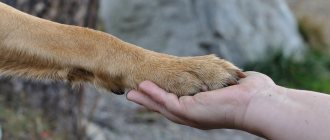How to train an adult dog in a new home
Will an adult dog be able to get used to a new owner? One of the main reasons why novice dog breeders buy puppies is that it is much easier for a baby than for an adult animal to get used to a new owner, his lifestyle and needs. Indeed, the younger the dog, the easier it is to raise him and accustom him to new conditions. By caring for a puppy, you receive incomparable positive emotions associated with its growth, development and upbringing. Of course, there will be many difficulties associated with caring for the baby. However, all the good things that you put into your pet will be rewarded to you a hundredfold after a while.
As for getting used to the new owners of an adult dog, there is no clear answer. However, remember: your concern and desire to help your four-legged friend will not go unanswered.
How long will it take a dog to get used to a new family? Everything here is very individual: one dog will be able to get used to a new home quite quickly, while another will need much more time. We can say for sure: the younger the pet, the faster and easier it will adapt. Animals with a weak nervous system and cowardly by nature usually take a long time to get used to a new environment. The older the dog, the more stable his character is and the longer it takes to adapt to unfamiliar conditions. Only after the pet has adapted can you begin raising and training the dog.
Will an adult dog be dangerous for the new owner and his family members? How will she behave in the future and how to teach an adult dog to obey? It is quite difficult to predict the behavior of an adult dog in a new family. Sometimes a person brings home a dog found on the street. For several weeks, the animal behaves relatively well: it shows friendliness towards members of the household, demonstrates gratitude, then, having finally become accustomed, it begins to harshly dictate its terms and terrorize the new owner and members of his family. Living with such a dog becomes impossible, and sometimes even dangerous.
Quite often, a dog from the street quickly gets used to its new owner, does not cause any inconvenience and behaves like a well-mannered and full-fledged member of the family.
As numerous examples show, first of all, aggressive dogs are thrown into the street, then cowardly and nervous ones. Do not forget that in both cases we are talking about mental disorders in the animal.
Setting up in a new place
Usually the dog is interested in where it came. Enter your new home first, leaving your pet tied on a leash at the front door, in a carrier, or in the car if you arrived by car. Make sure the new home is safe for the dog so he won't get hurt. Broken glass, exposed wires, sawdust, spilled paint, etc. are dangerous.
Once you’ve made sure that the house is safe, let the dog in and let him explore all the rooms. Perhaps your pet is one of those who does not strive to examine everything quickly and does not show interest in a change of environment. Don't force your dog to explore its new home. Interest will come gradually.
During the first hours in the new home, show the dog his place where there will be a bowl of water and food. If the dog is still small, it may not immediately remember where you put the bowls. In the first days, lure your pet there with treats.
Place familiar objects and toys on the bed so that the dog quickly gets used to the new place. To reinforce positive emotions, give your dog a treat or play. Let her see the new home as a positive place. You can hide several treats in different places in advance - when the dog finds them while exploring the house, this will also create positive associations.
When things are sorted, take care of the dog’s safety in the house. There have been cases when animals tried to return to where they were taken from. Therefore, regularly check that doors and windows are closed.
The exact time frame for a dog’s adaptation to a new home after moving cannot be determined. Too many factors determine this indicator, including the character of the pet. Usually you can fully get comfortable in a new territory within 3-5 days. To make adaptation to the new environment easier, try arranging the furniture as it was in the old house. This way the dog will perceive the new home as less foreign.
Obedience training for an adult dog (with video)
How successfully can you train an adult dog and make it obedient? No one can guarantee that an adult dog will successfully complete the training course and become a good friend and helper for you and your family. The fact is that traditional training courses are designed mainly for animals under the age of one year.
In order for a dog to become well-mannered and obedient, it needs to attend special classes. There she will master the primary commands: “You can’t!”, “Come to me!”, “Walk!”, “Nearby!”, “Place!”, “Sit!”, “Lie down!”, “Stand!” and etc.
However, the dog must not only learn to perform the listed actions - his further behavior and character completely depend on your constant work with him.
Ancient centers of domestication
The question of where the first domestication took place also remains open. Previously it was believed that the oldest centers were East Asia and the Middle East. But in connection with new, earlier findings related to domestication, scientists from the University of Turku, led by Olaf Thalmann, decided to reconsider the generally accepted point of view. Mitochondrial genes were taken as a basis from the remains of representatives of ancient wolves, 18 ancient dogs, which were compared with the genes of 148 modern animals, including 49 wolves, 77 dogs and 4 coyotes. Genetic analysis showed that the dog’s probable homeland was Europe, not India. According to scientists, the closest relatives of the modern dog are found among some groups of European wolves.
An adult dog in a new home: pros and cons
There are pros and cons to keeping an adult dog in a new home. First of all, decide whether you need an adult dog. Of course, she has a number of advantages over a puppy: a well-mannered dog will not have to be taught to be clean, he will not ruin furniture, shoes, wallpaper and laminate flooring, and he will not bother you at night. However, do not forget that the animal may not be raised the way you want. Get ready for the fact that your new adult family member will not be perfect: he will be harder than a puppy, he will endure a change of environment and will not immediately recognize you as the leader.
At first, he will be afraid of the new home and, despite daily walks, go to the toilet anywhere. In addition, the dog may withdraw into itself and become depressed.
Be sure to find out why previous owners give away or sell an adult dog. It is quite possible that the dog has health or mental problems that are not noticeable at first glance. Let the specialist carefully examine the animal and study its veterinary passport.
Another disadvantage of purchasing an adult dog is its established habits and character. She may be afraid of explosions of firecrackers, fireworks, thunder and other strong sound or light stimuli.
If you decide to adopt an adult dog, you must be absolutely clear about all the possible problems that may arise. Are you ready to be patient and put up with (within reasonable limits) the habits of an adult dog?
If you want to adopt a dog from the street, know: many dogs really want to get into a new family, to find a reliable and fair friend. Such animals demonstrate in every possible way how pleasant it is for them to communicate with you: they run after you, caress you. As a rule, street mongrels are quicker than their purebred counterparts to accept the role of a companion dog.
Remember that at first you will be a stranger to the dog, and it is up to you whether he will respect you. Try to calmly, without disruption or stress, adjust the dog’s behavior to suit you and your lifestyle.
However, sometimes homeless animals behave aggressively, laying down their ears, growling, tilting their heads forward, barking and even trying to attack. Such actions can be demonstrated not only by a large dog, but also by a very small mongrel. Even if your heart swells with pity, a dog that is aggressive towards you (provided that you do not threaten it, tease it or provoke it) should under no circumstances be taken into your home! The best advice on how to socialize an adult dog in a new home, raise and train it can only be given by professional dog trainers or experienced owners.
If you do bring a dog into your home from the street, first carefully examine it and immediately show it to the veterinarian. After the examination, if everything is in order, wash the dog, treat it with a drug against external parasites, and get rid of worms.
Guard breeds for home protection
Each dog has a sense of its own territory, which it will protect. Even the instincts of a small dog allow it to show aggression towards a well-wisher. Very often we can come across stories that a Chihuahua or a French bulldog has shown guard qualities. But still, some breeds were specially bred for such purposes. Let's take a look at watchdogs.
- Moscow watchdog. They became popular in the middle of the last century, when they began to be used for security. The dogs are not picky about grooming, they are very persistent and hardy. They can easily tolerate the cold while in a booth in winter. This is a loyal and brave guard dog breed. Her genes contain the qualities of a St. Bernard, a sheepdog and a hound;
- Saint Bernard A good guard who is easy to train. They differ in that they get along well with their families and have a balanced psyche. The imposing size can scare even the most avid stranger away from your home. Such dogs need regular proper nutrition and care for their coat. Products must contain phosphorus, vitamin D and calcium;
- German Shepherd. A breed characterized by intellectual abilities and the ability to analyze a situation before attacking. Of course, this can also be influenced by the dog's training. Shows good security abilities, as it was previously used for herding sheep;
- When thinking about what kind of dog is best to get to guard a private home, you can take a closer look at the Alabai. They are intended for grazing livestock. But now they have begun to be used as guard dogs due to their guarding skills, observation and endurance;
- Caucasian Shepherd Dog. A distinctive feature is the dog’s watchdog qualities. Such a defender knows the boundaries of the territory, so he is unlikely to catch up with the attacker. But the fact that he will not allow anyone into the guarded facility is certain;
- Doberman. The dog is very devoted to its owner, is distinguished by understanding and developed mental abilities. The dog can not only be a good guard, but is also distinguished by its agility and speed. In addition, these dogs are very graceful and beautiful;
- The Rottweiler understands perfectly where his friends are and where the “strangers” are. Therefore, he can easily protect his flock, territory or private home. The dogs have a muscular build and a well-developed musculoskeletal system. They interact well with both families and young children.
Other dog breeds, such as the Airedale Terrier, are also used to guard the home. Although the dog is considered a hunting dog, it is becoming increasingly popular as a home guard. The breeds discussed above are excellent for both protecting territory and attacking intruders.
It is important to properly train your dog to respond to attempts by ill-wishers to enter the yard.
There is also a group of dog breeds that exhibit good guard qualities, but are less effective in protection. Indeed, it is not always necessary for the dog to attack. Sometimes you can limit yourself to loud barking. Let us consider with you which breeds can guard a private home:
- West Highland White Terrier. This dog breed is classified as medium. But, despite such a small size, in comparison with larger home guard dogs, such as the Moscow watchdog and others, they can perfectly protect the premises and yard;
- Basset hounds are also small in size and are suitable for inexperienced owners. They can be a little playful and adamant. This should be perceived as one of the qualities of a dog’s temperament and try to find a common language with the animal;
- The Irish Setter is perfect for guarding an apartment. Take a closer look at this dog if you have children or other animals at home.
So, among the different breeds of dogs, there are many that are specifically designed to protect the home. The best dogs for protection can combine the qualities of a guard dog, a hunter, and in some cases, get along well with children. Basically, we described guard dog breeds that have an instinct in their genes to understand the territory and the need to protect it
It is important for you to have a correct and friendly attitude towards the animal, its upbringing and caring for the dog. Then the dog will begin to understand that he is considered part of the family and will begin to treat everyone close to him kindly.
Do you want your dog to be obedient? Order a walk with elements of training!
Find out more
submit your application
Should I adopt an adult sick dog?
Often, out of pity, people take a wounded or crippled dog into their home. Such an act is certainly worthy of deep respect. If you want to adopt a sick adult dog, you must have certain skills in communicating with animals and providing first aid to them. If you do not have such experience, it is better to entrust the care of the dog to a veterinarian, and then try to place it in good and, most importantly, capable hands.
Very often, new owners do not suspect that contact with stray dogs can pose a serious danger not only to them, but also to others: such animals are often carriers of various diseases. In addition, a stray dog may have a bad character and it will be extremely difficult to re-educate him (if at all possible, since his character and habits have already been formed in adulthood). Remember: a sick or injured dog sometimes needs to be treated constantly, so seriously consider whether you are willing to make such a sacrifice.
How to distinguish an abandoned dog from a lost one? A lost dog is easy to recognize. See if she has a collar with a tag on it. If there is nothing like that, check for a mark in the ear or groin (in purebred dogs) or a chip (many animals, especially valuable and rare breeds, are microchipped). If you happen to come across a dog with such signs, try to return it to its owner. If you have a brand, contact the kennel club; if you have a chip, contact a veterinary clinic.
Sometimes the dog only has a collar and it is clearly visible that it is domestic (clean fur, eyes and ears, well-mannered, perhaps even following some commands).
Post notices about the find within a radius of 0.5-1 km from your home, write on the Internet, call kennel clubs and dog trainers.
Who are mongrels?
This is the most numerous order, whose representatives are called “complex polyhybrid” by experts, and people simply call them mongrels. Pedigree dogs have been bred for decades, collecting the best qualities in each offspring. For some, flair is of paramount importance, for others - strength and endurance. Any puppy from a purebred dog is predictable - it is always known in advance what will grow out of it. For example, spaniels can only produce a spaniel and not any other breed.
Mongrel puppies are the result of free crossing, so neither appearance nor character traits are fixed at the genetic level. A small fluffy ball can grow into a charming and intelligent dog, although it is possible that it will not live up to expectations either in its external qualities or in its intelligence. This, however, happens very rarely. Most owners of mongrels would not exchange their pet for any dog, even the most beautiful purebred one. It is very difficult to classify mongrels, they are so diverse.
How to socialize an adult dog: introductions, behavior options
Getting to know an adult dog should be friendly and calm, regardless of whether it is a mongrel or a purebred dog, small or large. First, determine how the animal reacts to you. Everything should be peaceful, without aggression and anger. Now you can get acquainted.
When you get closer, do not try to pet the dog right away. Perhaps the adult dog will not notice you at all and will go to his place or to the enclosure. This is normal for the initial stage of addiction, but only if there is no obvious aggression or panic. Try sitting down and calling the dog to you by calling its name or showing it a treat or toy. It's best if she comes up on her own. Until the animal wags its tail in response to kind words, showing that you are not dangerous, there is no need to pet it. Calmly extend your open palm forward and let the dog reach out and smell it. After this, try to stroke the animal, but not from above the head, but from below under the jaw, scratch the side of the neck or muzzle.
If the animal reacts aggressively, cannot calm down, does not make contact, do not take it, even if the owner refuses money and assures that the dog usually does not behave this way.
Every dog is unique and original in its own way. However, there are common behaviors in dogs.
When encountered, a cowardly dog bends down to the floor, tucks its ears and tail, whines, and tries to jump to the side or run away altogether. Such a dog has difficulty adapting, is afraid of loud voices and sharp sounds, strangers, other animals and unusual objects. If you're lucky, the dog will soon calm down a little, but in a critical situation, cowardice may appear again.
A cowardly-aggressive dog has all of the above signs, sometimes it attacks, barks loudly, tries to attack and immediately recoils in fear. In a state of panic, it can become almost uncontrollable, not respond to commands, and seriously injure a weak or frightened person. If someone gives a noticeable rebuff, the animal runs away squealing.
A dominant aggressive dog sometimes attacks without warning, silently, actively, often fights with other animals, and may bite a stranger for no reason while walking. It is difficult to care for such a dog; he simply will not perceive your actions. Only a canine instructor or even an animal psychologist can accustom him to the new order. But still, in our opinion, this animal should be abandoned.
A mentally adequate dog, when meeting you, will either not pay attention to you, or will show some calm interest: it will come up, quietly sniff, and allow itself to be stroked. With further proper handling of such an animal, no problems should arise.
If you buy a dog from an owner, ask him for all the dog equipment, toys, bowls and even bedding - this will make it much easier for the animal to get used to new conditions. If you decide to adopt a dog from the street, be sure to take care of everything necessary for it.
Your task is to immediately establish strict rules and strictly follow them in the future. This will help the pet quickly gain respect for you as its owner-leader and take its place in the family.
How to attract an animal's attention and approach it
How many times a day should you feed an adult dog and a puppy?
If you need to attract the attention of an animal, you should act carefully, following the safety rules:
- You need to beware of aggressive dogs. You should also avoid dogs that show symptoms of rabies.
- You should not look into the eyes of an unfamiliar dog. For them, direct gaze means a challenge, so it is better to look a little to the side.
- You can draw the animal's attention to yourself by snapping your fingers or clicking your tongue. You can try to call the animal, but in a calm tone, so as not to scare it or cause aggression.
- You should approach a dog whose attention has already been attracted slowly, avoiding sudden movements. You cannot squat in front of him, it is better to stay at a distance of 3-4 meters.
- Having approached the permitted distance, you should wait for the stray dog to come towards you. If he wags his tail welcomingly, then it is permissible to extend your hand in his direction, but you need to hold it with your palm down. It's best to have something tasty in your hand to help establish contact.
Training and teaching commands for dogs
While your dog is getting used to his new home, try to create a calm environment. Do not invite guests, do not play loud music, etc. Let the dog calmly settle in, try not to leave it alone for a long time. At the same time, do not force communication on the dog and ask other family members about it. Many indoor street dogs find it very difficult to be locked up for a long time, as they are used to constantly moving. You will have to go for a long and active walk so that the dog can run around with other dogs and relieve the stress of being confined. It is on the street that you begin to give commands to train dogs. Start with basic commands, and as you master them, complicate the tasks.
Despite the fact that the dog gets used to new conditions, start training from the very first day. Under no circumstances forgive her for her mistakes and various pranks, even small ones, making allowance for the fact that the animal is stressed.
The most important thing in the process of training and teaching a dog commands is your love, affection and patience. Do not rush and do not expect that the dog will love the whole family from the very first day of his stay in the house and accept your rules entirely. Be patient - this will take some time. To raise a dog taken from the street, you will need several times more kindness. Don't be discouraged if things don't work out right away and don't give up. After all, a happy time has now come for both of you: a real, beloved, best owner has finally appeared in the dog’s life, and next to you is the most wonderful four-legged friend.
Why is socialization needed at all?
Without socialization, the dog will not be able to get used to new conditions, animals and people. This is not just a process of contact between a dog and other creatures. This also includes habits that will help him respond adequately to various minimal stimuli. In the city, this could be the noise of cars, the screams of children, etc. This also includes a reaction to people, dogs, cats, and other animals that do not pose a danger to the dog.
Socialization is a very important skill that needs to be taught from early childhood. Otherwise, the dog will twitch at every rustle, sound, stranger and show strong aggression. This negatively affects everyone, primarily the nervous system of the pet itself. Important! You cannot do without socialization if you want to have a kind and happy animal at home.
Competent socialization is the basis of peace between animals
How to Avoid Dog Fights
Dogs fight in their pack for only one reason - they do not have a strong leader.
This is why setting rules, boundaries and limits for the entire pack is so important. If all the dogs see you as the leader of the pack, they won't look at each other as rivals.
It is important to walk your dogs together, side by side. Not only does this reduce their energy levels and the likelihood of fighting, but walking together gives them the opportunity to focus on a single goal rather than each other.
Remember: the worst thing you can do for dogs that fight constantly is to isolate them from each other. Socialization is the key to a balanced dog.
This creates a separate territory for each dog, and competition for territory is a natural cause of fights between pack members. If dogs smell each other's scent, the conflict will develop into obsessive behavior. If they get close again, a collision cannot be avoided.
https://petstory.ru/knowledge/dogs/dog-training/kak-podruzhit-dvukh-sobak/
https://lovely-dog.ru/poleznoe/kak-poznakomit-sobaku-s-sobakoy-ili-schenkom/
https://cesarsway.ru/kak-podruzhit-sobak.html#i-3
The puppy's adaptation process, how to help with adaptation
How to train a puppy - a few simple tips:
- Let the baby get comfortable, examine and sniff all the rooms in the house and its inhabitants. You should immediately limit the available area - the dog must clearly understand where its area is.
- You need to play with the puppy, as out of boredom he can start chewing furniture. However, he shouldn’t get too tired. It is important to maintain a balance of activity and rest.
- From an early age, when the puppy is only a couple of months old, you need to start training him. It is very important to reinforce the animal’s correct behavior at the initial stages: determine its place, feeding schedule and play time, and begin toilet training. Training of children should take place in the form of multiple repetitions.
- During the first week, you should not allow other pets near the puppy if they reacted aggressively to the new family member. It is not recommended to completely limit their contact, only physical: you can put a partition so that the animals cannot attack, but have the opportunity to walk nearby, see and hear each other.
Note! Puppies are like children; cruelty and rough treatment are unacceptable towards them; they cannot be punished. All training and taming should be done in a patient, gentle manner.
Animals need to be trained from an early age
We care about health
To maintain the health of your four-legged pet, you should follow a number of preventive recommendations. The most important of them are vaccination and antiparasitic treatment.
Vaccinations
The first vaccination against hepatitis, enteritis, parainfluenza, leptospirosis and distemper is usually given by the breeder himself. It occurs for 2-2.5 months. After 21-28 days, the puppy is revaccinated. For convenience, they arrange it so that the revaccination coincides with the time of rabies vaccination. Then the animal is vaccinated once a year.
Treatment for parasites
Treatment for worms is carried out every quarter, and for external parasites (fleas, ticks, lice eaters) - as needed. All funds are selected individually.
Finding a veterinarian
In addition to vaccinations and preventive examinations, a veterinarian may be required in various force majeure situations. For this reason, it is better to look for it in the nearest veterinary clinics.
At the first appointment, be sure to ask the doctor about the breed characteristics of your pet and the medications that need to be added to the previously purchased first aid kit. If he doesn't mind, take his contact number in case you have questions in the future.
Taming
It is not known for certain how exactly domestication occurred - there are no written sources left, and archeology is poor in such details. Apparently domestication was preceded by a period of domestication. It was not yet a dog, but a wolf (jackal, fox, hyena, depending on the area of habitat), which came to a person’s home, seduced by the smell of food. Fed individuals could constantly visit the person, who soon found benefit in a dangerous neighborhood. The man began to catch wolves and take puppies from the den. When they grew old and died, he caught new ones. At some point, this method became inconvenient. Firstly, it is unknown when the “dog” will die, and secondly, new wolf cubs must first be found, and then raised and taught not to attack their own. But any delay is fraught - “man is a wolf to man.” This is where the idea to start breeding obviously came. They began to keep several “dogs” in the family, which ensured a change of generations without interruption.
We pick up a puppy from the breeder
If you are taking a puppy from a breeder of the breed, then it will be useful for you to find out some details about keeping the pet, and in the future you can always turn to the breeder for advice, because he has experience in raising dogs of this breed.
What you need to know
Ask the breeder about the character traits of your puppy; as a rule, they have time to prove themselves by the age when they are looking for a new home.
Photo: Cole Young
Information about the puppy’s previous living conditions will be useful; it will make it possible to minimize stress by creating familiar living conditions for him.
It is important to clarify what veterinary procedures were performed on the puppy: deworming, necessary vaccinations, etc.
What to take with your puppy
When picking up a puppy from the breeder, do not forget to take the pet’s veterinary passport, which should indicate the veterinary treatments performed, as well as documents confirming the pedigree (puppy card or birth certificate).
It would not be a bad idea to ask the previous owner of the puppy for some thing or toy that was close to the mother and offspring and absorbed their odors. They will remind the puppy of home and will allow him not to feel lonely; these things will be especially useful on the first night.
How to transport a puppy
Soft carrier bag
Keep in mind that on the way he may wet himself or get seasick, so agree with the breeder in advance about the time and ask not to feed the puppy before the trip, and also take water, napkins and bags with you.











